 |
Number of versions: 17
Edition: February 21, 2005
|

With thanks to Coen Peters - NL and Tsutomu
Kondo - J for their assistance.

In Japan three versions of the Monopoly games are issued, namely:
-
The American set, with streets from Atlantic City, at which
the text is always (partly) bilingual, so Japanese and American.
-
The Japan - Tokyo version, in which game the streets and stations
are districts and railways of the capital city of Tokyo.
-
The Japan - Cities version, in which the streets are cities in various
districts of Japan and the stations are main railways of the
country.
The spaces of the bilingual Atlantic City version are (in the standard
issue) from GO
onwards:
Mediterranean Avenue - Community Chest - Baltic
Avenue - Income Tax - Reading Railroad - Oriental
Avenue - Chance - Vermont Avenue
- Connecticut Avenue - Just Visiting
- St.Charles Place - Electric Company
- States Avenue - Virginia
Avenue - Pennsylvania Railroad - St.James
Place - Community Chest - Tennesse Avenue
- New York Avenue - Free Parking - Kentucky
Avenue - Chance - Indiana Avenue
- Illinois Avenue - B.& O. Railroad
- Atlantic
Avenue - Ventnor
Avenue - Water Works - Marvin
Gardens - Go to Jail - Pacific
Avenue - North Carolina Avenue -
Community Chest - Pennsylvania Avenue - Short
Line - Park Place and Boardwalk.
In the Japan - Tokyo version the names of the spaces are from GO
onwards:
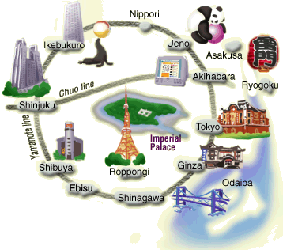 Kitasenju
(Northern thousand dwellings) - Community Chest - Hachiouji
(Eight princes) - Income tax - Odakyu (Department store & railroad) -
Kinshicho (Silk thread town) - Chance - Nakano (Middle field)
- Takadanobaba (Takada horse field) - Put into Jail
- Ueno (Upfield) -
Teito denryoku (Imperial capital electric power) - Asakusa
(Shallow grass) - Jiyugaoka
(Freedom hill) - Toubu tetsudo (Eastern part railroad) -
Kichijouji (Lucky omen temple) - Community Chest -
Kanda (Soul field) - Denenchoufu
(Field
park) - Chuushajou (Parking) - Ikebukuro
(Pond sac) - Chance -Toranomon (Tigergate) -
Harajuku (Field lodging) -
Keio tetsudo (Flourishing capital railroad) - Nipponbashi
(Japan bridge) - Marunouchi
(Within the circle) - Tokyo
suido kabushiki kaisha (Tokyo water district Co.Ltd.) -
Shibuya
(Reluctant valley) -
Go
to prison - Aoyama (Blue mountain) -
Roppongi (Six trees) - Community Chest-
Shinjuku (New
lodging) - Seibu tetsudo (Western railroad) -
Chance - Akasaka (Red slope) -
Buppinzei (Excise) and Ginza
(Silver seat). Kitasenju
(Northern thousand dwellings) - Community Chest - Hachiouji
(Eight princes) - Income tax - Odakyu (Department store & railroad) -
Kinshicho (Silk thread town) - Chance - Nakano (Middle field)
- Takadanobaba (Takada horse field) - Put into Jail
- Ueno (Upfield) -
Teito denryoku (Imperial capital electric power) - Asakusa
(Shallow grass) - Jiyugaoka
(Freedom hill) - Toubu tetsudo (Eastern part railroad) -
Kichijouji (Lucky omen temple) - Community Chest -
Kanda (Soul field) - Denenchoufu
(Field
park) - Chuushajou (Parking) - Ikebukuro
(Pond sac) - Chance -Toranomon (Tigergate) -
Harajuku (Field lodging) -
Keio tetsudo (Flourishing capital railroad) - Nipponbashi
(Japan bridge) - Marunouchi
(Within the circle) - Tokyo
suido kabushiki kaisha (Tokyo water district Co.Ltd.) -
Shibuya
(Reluctant valley) -
Go
to prison - Aoyama (Blue mountain) -
Roppongi (Six trees) - Community Chest-
Shinjuku (New
lodging) - Seibu tetsudo (Western railroad) -
Chance - Akasaka (Red slope) -
Buppinzei (Excise) and Ginza
(Silver seat).
In the Japan - Cities version the names of the spaces are from GO
onwards:
Sapporo (HOKKAIDO) - Challenge -
Sendai
(MIYAZAKI
KEN) (ken= district) - Souzokuzei (Succession taxes) -
Kitanihontetudou
(North Japan railway) - Niigata
(NIIAGATA
KEN) - Chance - Toyama (TOYAMA KEN) -
Kanazawa (ISHIGAWA KEN) - Visiting the
Jail - Nagasaki (NAGASAKI KEN) - Denryoku kaisha
(Electricity company) - Naha
(OKINAWA KEN) - Fukuoka
(FUKUOKA KEN) - Minaminihontetudou
(South Japan railway) - Matuyama
(EHIME KEN) - Challenge - Takamatu
(KAGAWA
KEN) - Hiroshima
(HIROSHIMA KEN) - Chuushajou (Parking place) -
Gifu (GIFU KEN) - Chance -
Shizuoka (SHIZUOKA
KEN) - Nagoya (AICHI KEN) - Nishinihontetedou (West Japan railway) -
Nara
(NARA KEN) - Kobe (HYOUGO KEN) -
Suidoukaisha (Water works) - Kyoto
(KYOTO FU) (fu= metropolitan
area) - Keimusho e haire (Go to jail) - Chiba
(CHIBA
KEN) - Tokorozawa (SAITAMA KEN)
- Challenge - Yokohama (KANAGAWA KEN) - Higashinihontetudou
(East Japan railway) - Chance - Umeda
(OSAKA
FU) - Buppinzei (Luxury tax) and Ginza
(TOKYO
TO) (to= capital).
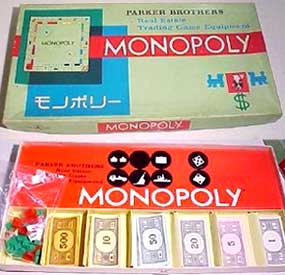 Edition: Standard, white box, without ref.nr. Edition: Standard, white box, without ref.nr.
"Parker Brothers
Real Estate Trading Game Equipment"
Publisher: Parker Bros./unknown inland manufacturer? -
1961
Dimensions of the box: 26 x 51 cm
The game:
Under the word Monopoly in closed, black characters on the
board it says:
Registered in US.
patent office
Registered in Japan patent office
Parker Brothers trade mark
For its real estate trading game
equipment
Copy right 1935, 1946 by Parker
Brothers Inc.
Made in Japan under licence
from
Parker Brothers, Inc.
This vague description of the rights Parker Brother claim indicates, like
elswhere in the world in the sixtees (see f.e. with Germany, France and the
Netherlands) a reorientation of Parker Brothers and a consolidation of their
share of the market.
The first issues of this for many years going version appeared in America in
1961. Because of the very many matches with this American edition it is very
likely this set was also published in 1961.
For obscure reasons 3 Atlantic City streets have
been replaced by 2 (probably) New York streets and a park, viz.:
Mediterranean Avenue became West Side
Avenue
Connecticut Avenue became Central
Park
North Carolina Avenue became Fifth
Avenue
The back of the game
board is grijs.
The left side of the lid of the white box show the board in a green and blue
square. Underneath the red Monopoly bar is a picture of Uncle Pennybags in a red
square, between 2 blue locomotives. Just
like with the American issues there is a green $-sign
underneath the red square. At the bottom of
the blue
square is Monopoly written in Japanese characters. The flanks of the lid on the
other hand show the red Monopoly bar again.
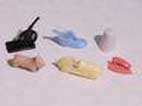 The
innerbox contains a white cardboard tray for the banknotes as well as a red
insert that show 3 of the tokens, viz. car, canon and boat. These
tokens are probably made of colored plastic? (This strongly reminds
of the very special colored tokens of the French edition in the "plaid
pattern (1)" box of 1958.) On top the 3rd O of Monopoly are 2 dice
showing a 5 and 2. The
innerbox contains a white cardboard tray for the banknotes as well as a red
insert that show 3 of the tokens, viz. car, canon and boat. These
tokens are probably made of colored plastic? (This strongly reminds
of the very special colored tokens of the French edition in the "plaid
pattern (1)" box of 1958.) On top the 3rd O of Monopoly are 2 dice
showing a 5 and 2.
Thee 7 banknotes do not contain any text.
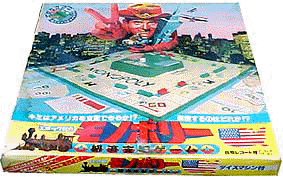 Edition:
Standard, ref. 05241 Edition:
Standard, ref. 05241
"pat.593449 - pat.pending"
Publisher: Parker Bros./Epoch Comp.Ltd. - 1982
Dimensions of the box: 50.8 x 50.8 cm
The game:
This set is owned by David Carter - California.
Because of the fact a patent number is shown next to the mention "pat. pending"
this issue must be older than the next one.
However, I estimate the date of issue not earlier than 1982 because a socalled Playmaster was issued in that year as well, both in America and
in a number of European countries. (However that instrument has many more
functions than rolling dice only.)
It is a mystery to me why such a hotch-potch of references to America is collected on
the lid like: the American flag in the shape of the country - a cowboy embracing
a bundle of skyscrapers and the steamengine of the early days of the American
Monopoly editions.
The game board (with blue green
back) is not folded, because of the "dice machine". That is why
it lies at the bottom of the box with a specially shaped, red
plastic "bankers's
tray" and a neutral white cardboard insert. It is also interesting this
red tray containg specially shaped holes for
the 7 tokens. They are resp.: hat - car - shoe - thimble - iron - dog and
rider-on-horse.
Because the dice machine is fixed on the board's centre the word Monopoly is in
closed black characters just above the first side of the game board.
Narrow blue and red
spaces next to this instrument indicate the place where the Community
Chest and Chance cards must be situated.
The money consists of 7 nasty neutral banknotes of colored paper
one-sided printed in black with a number only, viz.: 1 (on white) -
5
- 10 -
20 - 50 -
100 and 500 dollar.
The Rules are in a little booklet with illustrations, while the text is
in Japanese only.
This set is "Made in Japan".
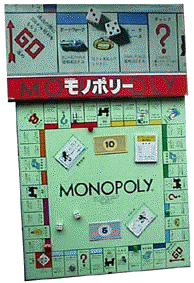 Edition: Standard,
ref. 05242 Edition: Standard,
ref. 05242
"pat.593449"
Publisher: Parker Bros./Epoch Comp. Ltd. - 1982
Dimensions of the box: 25.6 x 51.2 cm
The game:
Because the European editions of 1982 have the same design on the lid, viz. a
part of the 4th side on top a red
bar with the word Monopoly (in this case in Japanese characters) this issue must
be from about 1982. The board's midfield doesn't show any copyright year.
However, there are other signs indicating this set to be issued about 1982, viz.:
 |
The word Monopoly on the blue green
midfield of the game board.
This is in black characters (without frame), parallel to the first
side. |
 |
The rent of the unbuilt most expensive yellow
street is already $ 24 (so slightly higher than those of the other streets of the group). Untill about
1980 it always have erroneously been $ 22 in all countries. |
The game board's back is light blue with
a black tape in the middle.
More than halfof the innerbox is filled up with a light
blue cardboard insert showing Monopoly in white characters. The rest
of the box contains a cardboard insert with 7 trays as "banker's tray".
There is nothing on the bottom side of the box.
The money consists again of 7 nasty neutral banknotes of colored paper
one-sided printed in black with a number only, viz.: 1 (on white) -
5
- 10 -
20 - 50 -
100 and 500 dollar. They are also a bit smaller than usual (49 x 93
mm). The property cards have a circled number in the lower right corner.
This numbering is absolute arbitrary because nr 1 = Marvin
Gardens, nr 4 = Tennessee Ave.
and nr 7 =
Connecticut Ave.
The backside of the Chance-cards is red,
with Chance recurring printed in white. The Community Chest-cards have a blue
back with
Community Chest recurring printed in white. Also these cards are numbered. The
sole "legible" text on these cards is "Epoch Company Ltd.,© 1936
Parker Brothers.Inc." They have the same funny illustrations as those of
the well-known yellow
and red cards from the American
issues.
The 7 metal tokens are hat - car - shoe - thimble - iron - dog and
rider-on-horse. The white dice have clear black pips. The green
houses and red hotels do have
a chimney and they are made of plastic.
The white dice have plain Black pips.
The Rules are in a little booklet with illustrations, while the text is
in Japanese only.
The price of this set amounted in 1992 to US$ 40.- at the Parker Brothers Cons.Rel.Dept.
in Beverly-MA.
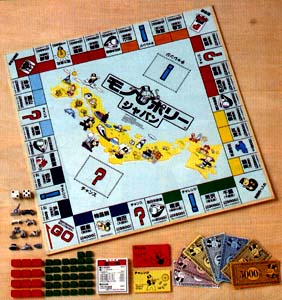 Edition:
Monopoly
- Japan - Cities Edition:
Monopoly
- Japan - Cities
Publisher: Parker Bros./Tomy Co.Ltd. -
before 1985
Dimensions of the box: 25.6 x 51.2 cm
The game:
This issue is a real Japanese game in all aspects: it only concerns Japanese
cities, the language is Japanese and even the
illustrations are characteristic
for this set. Looking at the game
board more closely it is not only striking
that the islands of Japan on the centrefield are nicely illustrated, but
also:
 |
The characters used for the word GO
are rounded, whereas the arrow is only half drawn. |
 |
The words Challenge and Chance are used, however written in Japanese. |
 |
Instead of "Income Tax" on the fourth space (with house) "Succession
tax" have to be paid. |
 |
The "stations" show a picture of the Sinkansen, the
Japanese Highspeed train. |
 |
"Jake the Jailbird" became a very beardy rascal. |
 |
A very simple bulb illustrates the Electric Company field, whereas the tap
on Waterworks is rather substantial. |
 |
A tiny red car is parked under a big red
P. |
 |
A Japanese "Officer Edgar Mallory" sends you to jail. |
 |
The space "Luxury tax" shows a ring as well as a necklace. |
The back of the gameboard is yellow.
The banknotes of this set have their proper design as well. It shows
"Uncle-Pennybags in-a-circle" 2x. The 10 metal tokens
however are again the well-known car - boat - hat - thimble - wheel barrow -
shoe - canon - dog - iron and rider-on-horse. The Chance cards are red,
the Challenge cards are yellow.
The price of this set amounted to ¥ 3,000 (US$ 24.-) in 1989.
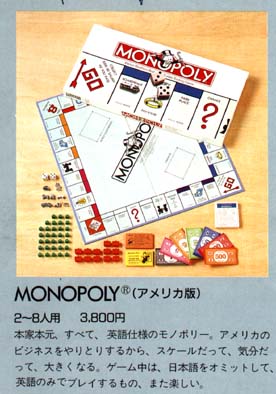 Edition: Standard,
USA ref. 0009 Edition: Standard,
USA ref. 0009
Publisher: Parker Bros./Tomy Co.Ltd. -
1985
Dimensions of the box: 25.6 x 51.2 cm
The game:
This is a full American set that for one reason or the other is also brought on
the Japanese market by Tomy. It maybe the
cheaper counterpart of the also in 1985 issued editions "The Tin" and
"The Case". (The picture is taken from the Tomy
catalogue.)
The white lid of the box shows the fourth side of the gameboard with the streets
of Atlantic City, including the racecar on Boardwalk. The bottom of the
box has a black/white picture of the gameboard with its accessories. The
box contains a narrow white plastic tray, while the other part has a blue
cardboard insert with those 13 FAQ's.
The back of the board is blue. The Chance- and Community Chest
cards with their funny illustrations of Uncle Pennybag are not only in "The
Tin" and "The case", but also in this cheaper version. The 8 tokens
are of metal.
The green houses and red
hotels are of plastic.
The price of this set amounted to ¥ 3,800 (US$ 30.-) in 1989.
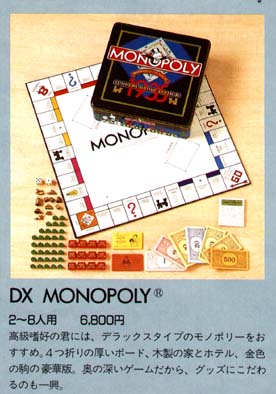 Edition: Tin
"1935" (DX Monopoly) Edition: Tin
"1935" (DX Monopoly)
Publisher: Parker Bros./Tomy Co.Ltd. -
1985
Dimensions of the tin: 8.4 x 27 x 27 cm
The game:
This set is "packed" in a very beautiful tin, upon which is in relief "Commemorative
Edition 1935". The flanks of the tin are illustrated with houses in
front of which Uncle Pennybags is active.
Also in this issue the gameboard with streets of Atlantic City
(with translation into Japanese) is used. This applies also for the nice
American Chance- and Community
Chest cards and (not numbered) property deeds. The solid board
has a black back and is folded in four to fit into the tin. Monopoly is in black characters (without
frame) parallel
to the 1st side in the center of the blue
green playfield. As in the American tin the red
wooden hotels are printed in gold with the name Grand Hotel. The green
houses are also of wood indeed,
but they are not printed. The 10 bronze
colored tokens are: clock - shoe - purse - thimble - rocking-horse - car
- boat - canon - iron and hat.
The banknotes are "Copyright 1935 by Parker
Brothers Inc.".
In the tin is a black plastic insert with
holes for as well the banknotes as the houses and hotels, the dice, tokens and
property cards.
The Rules are very luxury: They also report the history of the game in short
and are richly illustrated with a lot of versions of Monopoly sets.
The price of this set amounted to ¥ 6,800 (US$ 54.-) in 1989.
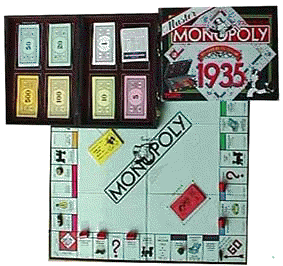 Edition:
Case
"1935" (Master Monopoly), ref.
362715 Edition:
Case
"1935" (Master Monopoly), ref.
362715
Publisher: Parker Bros./Tomy Co.Ltd. -
1985
Dimensions of the case: 5 x 19 x 27 cm
The game:
This is again such a nice, luxury issue, this time in honour of the 50th
anniversary of Monopoly. The smart case, covered with artificial leather,
fits in a colorful cardboard jacket that resembles the tin very much, i.e. showing
in large figures 1935 on top and the flanks
with a band of green houses. To my surprise
the flank of my set shows "© 1935 and 1990" that may indicate a
"re-issue"? Or does it perhaps indicate the Monopoly games having been
issued in Japan not until 1940 (just before WW II?)?
Because the case is small the game board have to be folded 3 times.
Its back is black. Although it is the Atlantic City version again with
all texts on the streets, property deeds and cards are in English, with
translation into Japanese, the rules are only in Japanese. However, it is strange
that these rules with many illustrations are those of the Monopoly-Japan edition.
What may be the meaning of that?
The moment the game will be played and the board and the green
box with equipment are taken out, it appeared the box to be destined as bankers
tray.
All attributes are exactly the same as those of "the tin", i.a. 10
bronze tokens, wooden houses and Grand
Hotels, bilingual property cards and common Monopoly banknotes.
The price of this set amounted to ¥ 4,500 (US$ 36.-) in 1989.
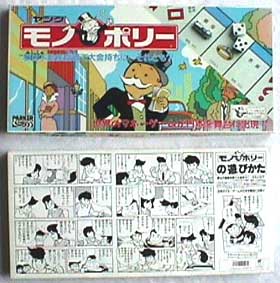 Edition:
Ya-N-Gu (young) Monopoly -
Japan-Tokyo, b.c. 20107 2 Edition:
Ya-N-Gu (young) Monopoly -
Japan-Tokyo, b.c. 20107 2
Publisker: Parker Bros./Kenner Parker (Japan) Ltd. - 1988
Dimensions of the box: 25.6 x 51.2 cm
The game:
Although the game board shows 1964 as latest copyright year this edition is only issued
in 1990.
The game is in Japanese only and contains the streets of Tokyo. The
stations show a black Parker Brothers locomotive. The blue
green playside of the game board show Monopoly in Japanese characters
in a frame sloping over the field.
There is a part of the 4th side on the lid as well, with the
dice showing the 3 and 5.
More than half the innerbox is filled with a blue
green cardboard insert showing Monopoly in black
characters in a frame. The rest of the box has a white plastic insert with 7
holes for the banknotes.
The most striking of this edition is the cartoon at the bottom. It is an
interesting way to explain "How to play Monopoly".
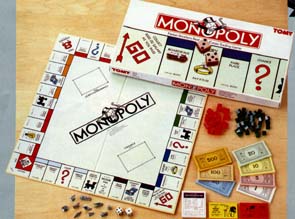 Edition: Standard,
ref. 362340 Edition: Standard,
ref. 362340
Publisher: Parker Bros./Tomy Co.Ltd. -
1989
Dimensions of the box: 25.4 x 50.7 cm
The game:
It takes some doing to determine when a certain edition has been issued. The
game board of this set shows as latest ©-date 1961, on the flank of the
lid it stays 1988, where as the Japanese rules from TOMY
mention the year 1989.
In comparison with the standard version of about 1985 (of Epoch Comp.) the
tables are turned: Now all texts on the game board are in English, with prices
in dollar, provided with Japanese subtitels. Also the property cards, the Chance-
and Community Chest cards are now full bilingual.
The lid shows the last part of the 4th side of the game board with on
top of it the well-known red bar with
Uncle Pennybags coming out the O. The light blue
midfield of the board shows in diagonal the word Monopoly in black
characters and frame. The back side of the board is light
yellow and has no visible ribbon in the middle.
More than half of the inner box is filled up with a light
green cardboard insert showing Monopoly in a black frame. The rest
of the box contains a white plastic insert with 7 holes for the attributes. The
bottom shows a black/white picture of the board with accessories and explanation
in 2 languages.
The money now consists of the well-known Monopoly-banknotes in the
denominations 1 - 5 - 10 - 20 - 50 - 100 and 500 dollar. The property deeds
are not numbered. The Chance- and Community Chest cards are the
well-known yellow
and red
cards from the American game.
The 10 metal tokens of this set are hat - car - canon - shoe -
thimble - iron - dog - rider-on-horse - wheelbarrow and boat. The dark green houses and red
hotels do have a chimney and are made of plastic.
The white dice have clear black
pips.
The price of this set amounted to ¥ 3,000 (US$ 24.-) in 1989.
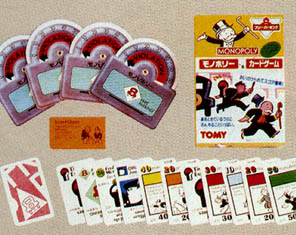 Edition: Free
Parking Edition: Free
Parking
Publisher: Parker Bros./Tomy Co.Ltd. -
±1989
Dimensions of the box: 19.0 x 26.5 x 7.5 cm
The game:
If for a Monopoly games collector a game has to comply with the demand that properties
can be bought with money in order so to become the richest
player Free Parking certainly not belongs to them. But since this card-game
so obviously refers to the Monopoly board many a collector would like to have
this game in his collection. For that reason I do describe it in this catalogue.
Object of this game is to be the first player to accumulate 200 points.
For this purpose each of the maximum of 4 players get a parking meter. By
drawing Feed the Meter cards the parking meter can be filled with a
number of minutes. This time you need to run errands with so-called Point
cards. On these are a number of points (to be accumulated) as well as a same
number of parking minutes (to be reduced on your parking meter). When you are or
will come in possession of one of the Officer Johns cards you are allowed
to play this policeman against any opponent. To protect oneself from such
teasings you should try to obtain one of the Free Parking cards.
Finally you may elect one of 32 Second Chance cards any moment you wish
to do so. Also these 45 x 77 mm red cards
with funny illustrations of Uncle Pennybags look very familiar. However, they
may be risky, but they add excitement to the game since they may help - or hurt
- you or your opponents.
The price of this set amounted to ¥ 2,000 (US$ 16.-) in 1989.
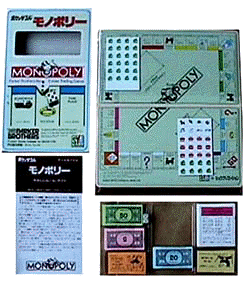 Edition: Magnetic
Pocket Edition - brown, no.102 Edition: Magnetic
Pocket Edition - brown, no.102
Publisher: Parker Bros./Gilco Ltd./SYU
creation - ±1991
Dimensions of the box: 1.5 x 10.5 x 18 cm
The game:
This is one of the games of the "Pocketable Series" of SYU
Creation, who even made a handy "collectors case" for them.
The smal game board is the one with the streets of Atlantic City
Japanese subtitled. It is in a brown
portfolio the size of a pocket diary. This portfolio fits in a cover
with a window at the front. In there appears the gold colored Monopoly bar of
the portfolio by putting it away. (The picture on the back of the cover suggests
that the portfolio is red.) The attributes
are in a tray of transparant plastic. The shapes of all parts are very small,
viz.:
 |
the (bilingual) property cards: 45 x 52 mm |
 |
the (bilingual) Chance- and Community Chest cards: 25 x 44
mm |
 |
the banknotes: 25 x 47 mm |
 |
the white dice: 5 x 5 x 5 mm |
Only the 8 tokens, the green houses
and the red hotels are small flat
squares who stick on the gameboard. There have no provisions been made for the
money nor the cards so that these things have to be kept in hand?
Not a very practical game that however has to be present in a collection.
The price of this set amounted to ¥ 1,200 (US$ 10.-) in december 1992.
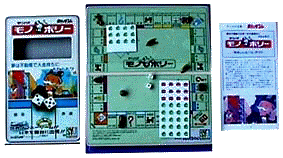 Edition: Magnetic
Pocket Edition - blue, no.112 Edition: Magnetic
Pocket Edition - blue, no.112
Publisher: Parker Bros./Gilco Ltd./SYU
creation - ca.1991
Dimensions of the box: 1.5 x 10.5 x 18 cm
The game:
The small gameboard of this only Japanese set consists of the districts
of Tokyo. It is in a blue portfolio
the size of a pocket diary. (This portfolio is in a cover the back of which
suggests that the portfolio is brown.)
It is striking that the 8 tokens (of yellowish
brown or grey plastic) of this set are threedimentional and consequently
cannot stick on the board but so more the chance to lose them.
The sizes of all attributes are equal to those of the former set.
The price of this set amounted to ¥ 1,200 (US$ 10.-) in december 1992.
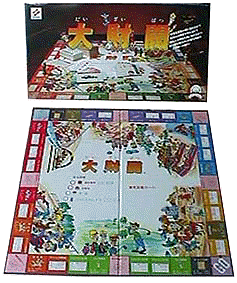 Edition: Dai Zai
Batsu (Big Money Clan), ref.BT104 380 Edition: Dai Zai
Batsu (Big Money Clan), ref.BT104 380
Publisher: Konami - 1991
Dimensions of the box: 26.3 x 51.6 cm
The game:
This entire Japanese game is in all aspects sunny and cheerful, which appears
immediately from the colorful cover.
Although it is a Monopoly-like game it deviates considerably on many
points, viz.:
 |
The players are capitalists indeed (considering the name of the game), but
instead of streets they buy golf-links, racecourses, race
circuits, furniture boulevards
(along the river Rine), islands in front of the Great Barrier Reef (N.E. Australia) and oilfields
(Saudi
Arabia?). |
 |
The groups always consist of 5 spaces: 3x "Great real estates"
and 2x "Small real estates" (illustration on the space).
One exception is the last (yellow
brownish) group that only consists of the 3 "Great real estate" spaces. |
 |
No houses nor hotels have to be built. The revenues of a property
depends on the weather. |
 |
On the midfield is but one stack of cards viz.of the Weather-conditions-cards.
These ought to be drawn on the 6 pink
spaces:
4x in the middle of each side, 1x on the Jail space and
1x on the Go-to-Jail space. Some of the texts on these cards are: |
 |
When you have reached the age of 40 you will be a pop star and make a
hit. You'll receive 50,000. |
 |
If you hold a mortgage at the bank you may draw any
Weather-conditions-card. |
For the rest there are 16 Age-cards and 10 Match-result-cards.
The money consist of small (45 x 95 mm) bank notes of various colors,
printed with the value denotation in a plain decoration. (The character after
the number states that it is 10,000 times as large) There are 6 colored, plastic
pawns as token. Half the inner box is filled with a white plastic insert
with 7 sections.
The rules are richly illustrated with explaining
pictures.
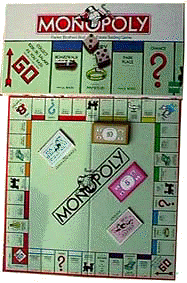 Edition: Standard,
ref. 071009 Edition: Standard,
ref. 071009
Publisher: Parker Bros./Hasbro Japan
- 1996
Dimensions of the box: 25.6 x 51.2 cm
The game:
This edition of the standard version resembles of course the earlier issues.
To get a good impression of the differences and matches the most relevant
features are placed in the table below.
|
Hasbro 1996
|
Tomy 1989
|
Epoch 1985
|
|
Uncle Pennybags in O of red
Monopoly-bar
|
Uncle Pennybags in O of red
Monopoly-bar
|
No Uncle Pennybags in Monopoly-line
|
|
board has red back
|
board has light yellow
back
|
board has light blue
back
|
|
Monopoly in black frame slanting over the board
|
Monopoly in black frame slanting over the board
|
Monopoly in black characters parallel to side 1 of the
board
|
|
texts on board and cards bilingual
|
texts on board and cards bilingual
|
texts in Japanese; on the board also with American names
|
|
no insert in box
|
lightgreen, cardboard
insert
|
lightblue, cardboard
insert
|
|
white, plastic tray with 12 holes
|
white, plastic tray with 7 holes
|
cardboard tray with 7 holes
|
|
"©1935,1996 Hasbro Int.Inc." on banknotes
|
"Copyright 1935 by Parker Brothers Inc." on
banknotes
|
very neutral banknotes
|
|
Chance-& Comm.Chest cards with "engines-pattern"
|
small Chance-& Comm.Chest cards like in the American
game
|
Chance-& Comm.Chest cards with repeated name at the
back
|
|
10 metal tokens
|
10 metal tokens
|
7 metal tokens
|
|
bluegreen houses
with excentric chimney
|
darkgreen houses
with chimney in centre of roof
|
lightgreen houses
with chimney in centre of roof
|
|
red hotels with
roof tiles
|
red hotels
without roof tiles
|
red hotels
without roof tiles
|
|
not numbered property deeds
|
not numbered property deeds
|
numbered property deeds
|
|
black/white picture at the back; explanation only in
Japanese
|
black/white picture at the back; explanation bilingual
|
no picture at the back side
|
This set was made in New Zealand.
The price of this set amounted to ¥ 2,300 (US$ 16.-) in 1989.
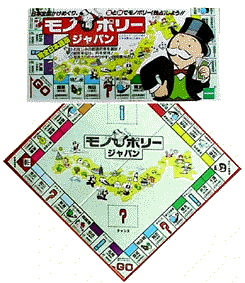 Edition: Monopoly
- Japan - Cities, ref. 071016 Edition: Monopoly
- Japan - Cities, ref. 071016
Publisher: Parker Bros./ Hasbro Japan -
1996
Dimensions of the box: 25.6 x 51.2 cm
The game:
This is a slightly embellished re-issue of the nice 1985 game.
The back side of the gameboard is red
now and the banknotes show "Uncle Pennybags-in-circle" twice.
Edition: Star Wars Limited Edition (Japanese text), ref.40786
Publisher: Parker Bros./Hasbro
Japan - 1997
Dimensions of the box: 25.7 x 51.0 x 5.3 cm
The game:
Also this Japanese issue in honour of 20 years anniversary of Star Wars is a "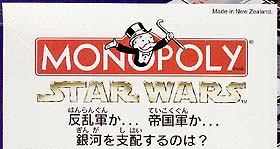 Limited Edition", because there is a dated sticker with number
on the game board. Although the box is of the same dimensions and reference
number as the American set it is not manufactured in the USA but in … New
Zealand. For the rest it is an exact copy of the American set, because all
spaces on the board are in English with Japanese subtitle. The cards however are
only in Japanese as are the richly illustrated 18 pages of the rules. The inner
box as well is partly filled by a carton showing the English text "Limited
Collector's Edition"! The other part contains a black plastic insert with 7
trays. Limited Edition", because there is a dated sticker with number
on the game board. Although the box is of the same dimensions and reference
number as the American set it is not manufactured in the USA but in … New
Zealand. For the rest it is an exact copy of the American set, because all
spaces on the board are in English with Japanese subtitle. The cards however are
only in Japanese as are the richly illustrated 18 pages of the rules. The inner
box as well is partly filled by a carton showing the English text "Limited
Collector's Edition"! The other part contains a black plastic insert with 7
trays.
(With the detailed picture from the bottom of the box: For the
translation of the Japanese text you have only to look at the American box to
understand that is says "Rebels … or Imperials … Who will control
the Galaxy?")
The most striking of this game are the 2 kinds of players (the Rebels and
Imperials) each having their own Vehicles and Properties. The Rules are exactly the same as those of the "normal" game, however
the differences are sometimes striking, viz.:
|
Monopoly standard
|
|
Star Wars Monopoly
|
|
6 to 10 tokens (hat, car etc.)
|
|
8 tokens: 5 Rebels, 3 Imperials
|
|
Streets with title deeds
|
|
Galactic properties and property cards
|
|
Income Tax/Luxury Tax
|
|
Docking tax/Bounty
|
|
The money = ¥
|
|
The money = Imperial Credits
|
|
--
|
|
5 "gold" Imperial coins; 1000 credits each
|
|
Green houses + red
hotels
|
|
2 sets of space vehicles
|
|
Chance and Community Chest cards
|
|
Imperial en Rebel cards
|
Each token represents a well-known Star Wars character. The Rebel Alliance is represented by: Luke Skywalker, Princes Leia, Han Solo,
Chewbacca and R2-D2. The fighters for the Galactic Empire are: Darth
Vader, Boba Fett and the Stormtrooper.
The vehicles of the Rebels are the light gray
X-wing Fighters and Corellian Freighters and those of the Imperials are the
dark gray Tie Fighters and Star
Destroyers.
The banknotes are in various colors with the value indication on the
right side. The text with the illustrations on the banknotes is in Aurebesh!?
The bottom of the box not only shows a clear picture of the game board and
attributes, but also a good picture of the tokens: the "Heroes" and
the "Villains".
The price of this edition amounted to ¥ 6.200 (€ 45,-) October 1997.
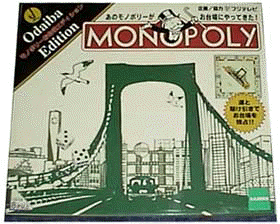 Edition:
Odaiba Edition, b.c. 17056 6 Edition:
Odaiba Edition, b.c. 17056 6
Publisher: Parker Bros./Hasbro - 1997
Dimensions of the box: 26.6 x 23.3 cm
The game:
The site www.tcvb.or.jp/en/infomation/2area/11rinkai.html
says about this very modern district of Tokyo:
"Odaiba was a vacant stretch of reclaimed land until
just a few years ago, but now an amazing selection of entertainment and
exhibition facilities have made Odaiba the most popular leisure destination
in Tokyo. Serving Odaiba is the
Yurikamome Line, a fully computerized unmanned train service taking in Rainbow Bridge,
which offers superb views of waterfront Tokyo and its ultramodern
architecture. The Yurikamome Line starts from near the Shiodome Exit of JR
Shimbashi Stn.
The Odaiba Line, meanwhile, heads into Odaiba from subway Shin-kiba
Stn. Odaiba Seaside Park, the Museum of Maritime Science, Palette Town, and
Tokyo Big Sight can also be reached by waterbus from Hinode Pier."
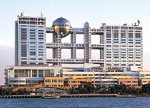 The
large bridge shown on the lid of this edition appears to be the Rainbow
Bridge and so the properties naturally are important companies and institutes on this
island. The
large bridge shown on the lid of this edition appears to be the Rainbow
Bridge and so the properties naturally are important companies and institutes on this
island.
Also dominating in the picture on the lid is the Fuji Television
building, as the picture shows. Located near Yurikamome Line Daiba Stn, this building is a
futuristic fantasy. Inside a massive spherical structure is an observation deck and
a TV museum.
Steve Amato from N.Y.C. could provide me with all property names
of the game board, which are from Go on:
Rainbow Bridge - Tokyokou
Tunnel - Tokyo Musen Taxi - Fune No Kagakukan
- Searia Odaiba - Odaiba Kaihin Kouen
- Jail - Nippon Broadcasting Systems, Inc.
- Ariake Clean Center - MX-TV - Tokyo Seaside Story
- Yurikamome - Tokyo Fashion Town
- Ariake Colosseum
- Tokyo Big Site - Free Parking - Wanza Ariake Bay Mall
- Tokyo Joypolis - Sunset Beach Resturant Row
- Rinkai Fukutosin Sen - Ariake Frontier Building
- Aomi Frontier Building
- Tokyo Gas - Daiba Frontier Building
- Go to Jail - Hotel Grand Pacific Meridian
- Hotel Nikko Tokyo - Symphony Tokyo Bay Cruise
- Suijo Bus - Decks Tokyo Beach
and Fuji Television.
|